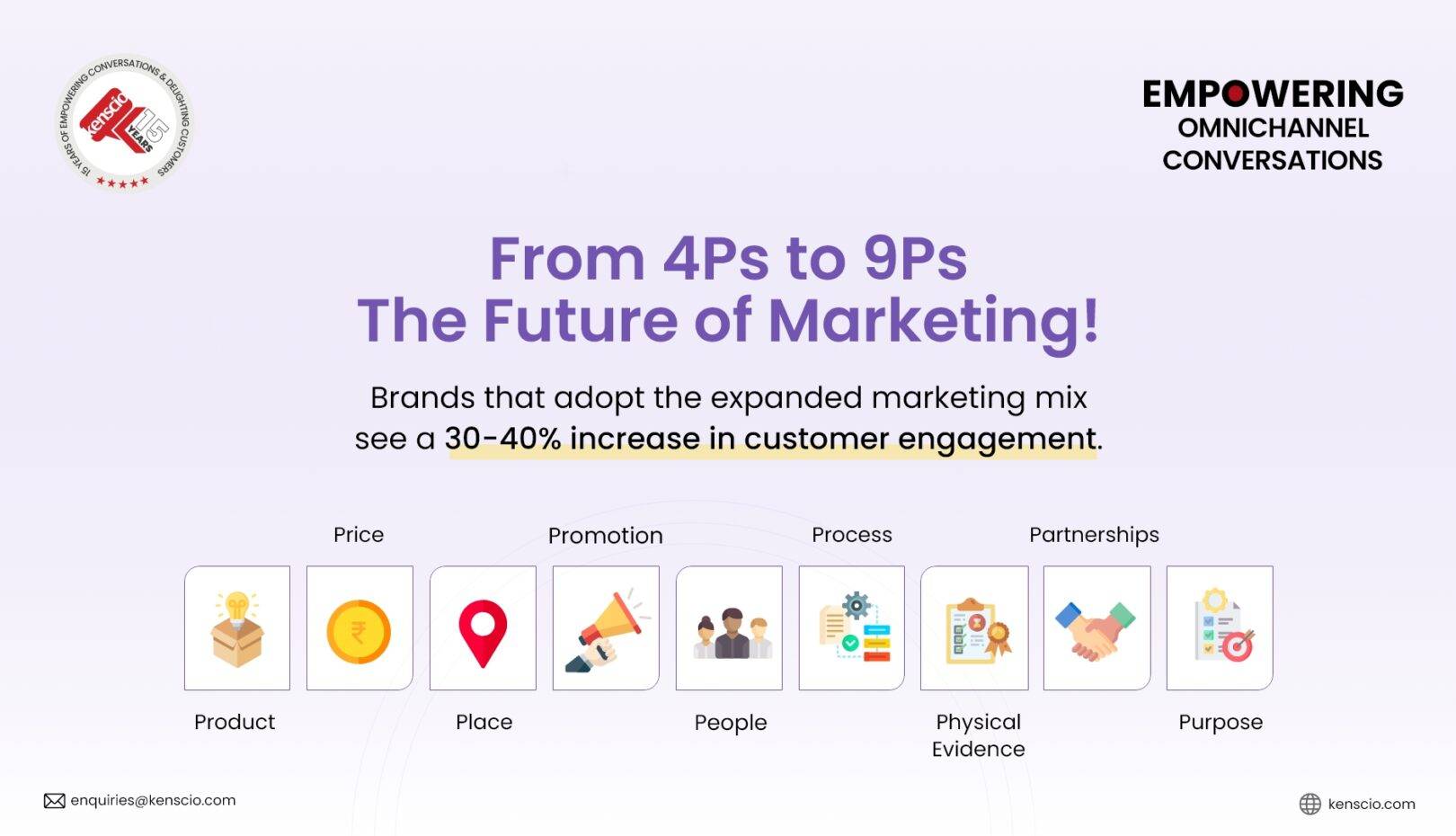- March 20, 2025
- by Parbeshkumar Maurya
The Evolution of Marketing Mix: From 4Ps to 9Ps for Business Success
Introduction: The Changing Landscape of Marketing
The traditional 4Ps of marketing (Product, Price, Place, and Promotion) have served as the foundation for marketing strategies for decades. However, as consumer behavior, technology, and market dynamics evolved, businesses recognized the need for a more comprehensive and customer-centric approach.
This led to the 7Ps model, incorporating People, Process, and Physical Evidence to address service-based industries. But today, with the rise of digital transformation, sustainability, and customer experience, marketers are embracing the 9Ps of marketing, adding Partnerships and Purpose to the mix.
According to McKinsey, brands that adopt an expanded marketing mix see a 30-40% improvement in customer retention and engagement.
In this blog, we’ll explore the 9Ps of marketing, their significance, and how brands successfully implement them to drive growth.
The 9Ps of Marketing: A Comprehensive Overview
The table below provides a detailed breakdown of the 9Ps of marketing, highlighting their significance in modern business strategies.
| Table: The 9Ps of Marketing and Their Role in Business Success | |
| P | Description |
| Product | Focuses on innovation, differentiation, and meeting customer needs to create a compelling offering. |
| Price | Determines the perceived value of the product and includes strategies like dynamic pricing, tiered plans, and value-based pricing. |
| Place | Ensures that products and services are available where customers need them, using an omnichannel distribution approach. |
| Promotion | Engages customers through storytelling, advertising, influencer marketing, and content strategies to create awareness and demand. |
| People | Represents employees and customers who influence a brand’s reputation and customer experience, emphasizing training and customer service. |
| Process | Covers the operational workflow that ensures a seamless and efficient customer journey, from sales to support. |
| Physical Evidence | Provides tangible proof of brand reliability, including packaging, branding, store environments, and testimonials. |
| Partnerships | Strengthens a brand’s market presence by forming strategic alliances, co-branding, and collaborative marketing efforts. |
| Purpose | Aligns business values with consumer expectations, incorporating sustainability, corporate social responsibility, and ethical marketing. |
The 9Ps of Marketing: An Integrated Approach
1️⃣ Product: Offering More Than Just a Commodity
A product is no longer just a physical good or service—it’s an experience. Customers demand innovation, personalization, and sustainability in the products they choose.
Example: Apple doesn’t just sell iPhones; it sells an ecosystem, combining hardware, software, and seamless integration.
Stat: 80% of customers prefer brands that provide personalized product recommendations (Accenture).
2️⃣ Price: Beyond Cost, It’s About Perceived Value
Price is no longer just about affordability—it’s about the value customers perceive in return for their money. Businesses now use dynamic pricing, subscription models, and psychological pricing to maximize revenue.
Example: Netflix uses tiered pricing to cater to different audience segments while offering premium experiences at higher prices.
Stat: 60% of consumers are willing to pay more for better customer experience (PwC).
The way products and services reach consumers has changed drastically. E-commerce, mobile commerce, social commerce, and traditional retail must work together seamlessly.
Example: Nike integrates online and offline retail through its website, mobile app, and flagship stores, offering personalized experiences through digital membership.
Stat: 73% of consumers shop across multiple channels before making a purchase (Harvard Business Review).
4️⃣ Promotion: Engaging Rather Than Just Advertising
5️⃣ People: The Power of Customer and Employee Experience
6️⃣ Process: Creating a Seamless Customer Journey
A streamlined process ensures efficiency, convenience, and frictionless customer experiences. Automation, AI, and CRM systems play a huge role in today’s marketing strategies.
Example: Amazon’s one-click ordering and fast shipping have set the gold standard for streamlined e-commerce experiences.
Stat: 86% of buyers are willing to pay more for a great customer experience (SuperOffice).
7️⃣ Physical Evidence: Building Trust and Credibility
Even in a digital-first world, consumers need tangible proof to trust a brand—whether through product packaging, store design, or online reviews.
Example: Tesla showrooms and test drives provide physical validation before customers make high-investment purchases.
Stat: 93% of customers read online reviews before buying a product (BrightLocal).
The Two New Ps for Modern Marketing
While the 7Ps expanded marketing for service-based industries, modern brands needed more than just an efficient process and strong people. They needed meaningful partnerships and a strong brand purpose to differentiate in an increasingly conscious marketplace—leading to the birth of the 9Ps.
8️⃣ Partnerships: The Key to Expanding Reach and Credibility
Strategic partnerships and collaborations help brands expand their audience, share expertise, and co-create value.
Example: Spotify + Starbucks Partnership – Starbucks integrated Spotify into its loyalty program, allowing users to influence store playlists. This boosted customer engagement by 28%.
Stat: Businesses engaged in strategic partnerships grow 35% faster than competitors (BCG).
9️⃣ Purpose: Aligning Marketing with Brand Mission
Consumers today care about sustainability, social responsibility, and ethical practices. Brands that integrate purpose into their marketing strategy gain loyalty and long-term trust.
Example: Patagonia’s “Don’t Buy This Jacket” campaign encouraged customers to be mindful of overconsumption, reinforcing its brand commitment to sustainability.
Stat: 64% of global consumers choose brands that align with their values (Accenture).
Why the 9Ps Matter for Modern Businesses
- Consumer-Centric Approach – Customers demand personalized experiences, transparency, and ethical marketing.
- Digital Transformation – E-commerce, social commerce, and automation require an integrated approach.
- Competitive Differentiation – Brands that embrace partnerships and purpose stand out in crowded markets.
Fact: Companies implementing the 9Ps framework see up to a 40% increase in brand loyalty and engagement (Deloitte).
Final Thoughts: The Future of the Marketing Mix
Sources & References:
McKinsey & Co.– Marketing Trends | Harvard Business Review – Consumer Behavior Insights | Accenture – Brand Purpose and Customer Loyalty | Deloitte – The Future of Marketing
